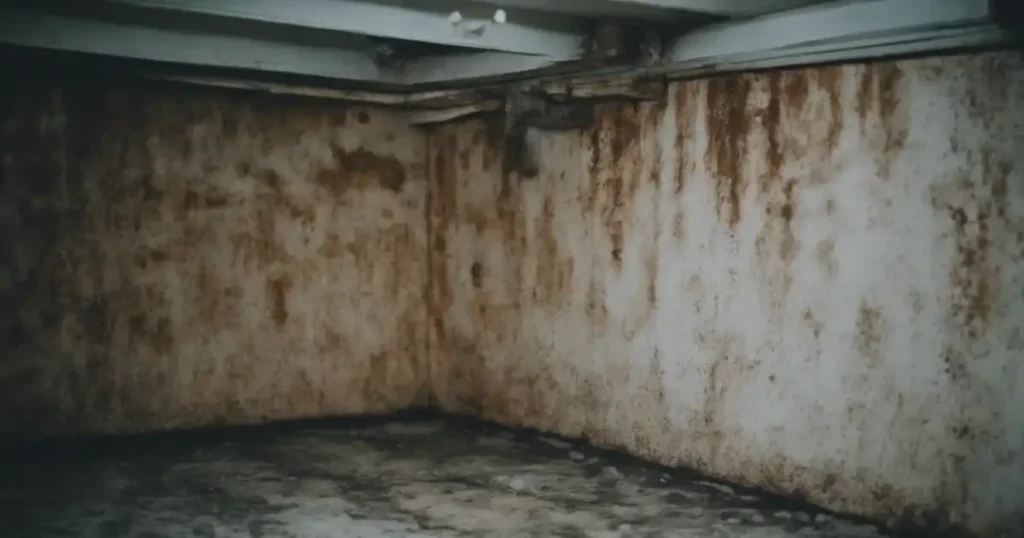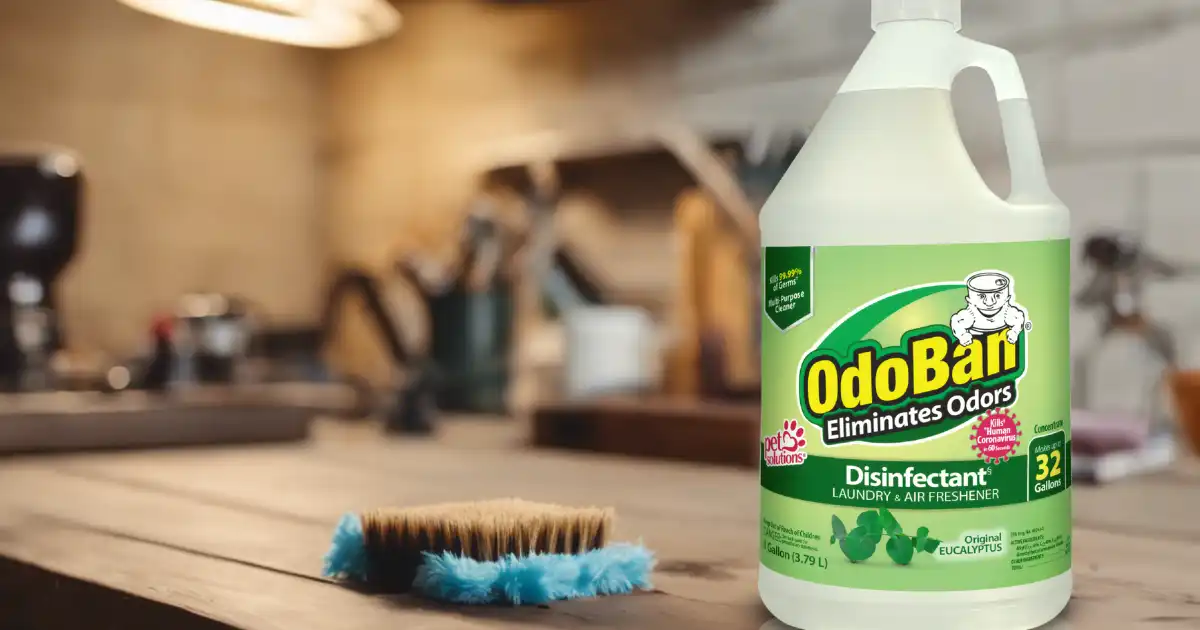Finding mold growing in your home can be an unsettling discovery. Those fuzzy spores seem to spread rapidly, covering walls and surfaces with their musty scent and web-like textures. Mold remediation can be expensive, so many homeowners seek cleaning products like OdoBan disinfectant.
But Does OdoBan Kill Mold?
No, OdoBan does not kill mold. It helps prevent new mold growth but doesn’t get rid of existing mold. To effectively tackle mold, it’s best to team up OdoBan with mold-killing cleaners during proper remediation.
Keep reading to learn how this disinfectant works against mold and mildew. We’ll provide proper usage guidelines for applying OdoBan during mold remediation. Additionally, we’ll share valuable tips on preventing mold from recurring after treatment. So, let’s dive in!
Exploring Mold Growth
Mold is a type of microscopic fungus that releases tiny spores that float through the air. When these spores land on a damp surface, they can attach and grow into the fuzzy mold patches we’re all too familiar with. Mold spreads quickly by creating new spores that then land elsewhere, starting the cycle anew.
But what encourages mold to successfully take root when it lands?
Moisture is the main offender. Whether it’s from humidity or water leaks, it creates an ideal environment for mold to thrive. In this environment, mold can anchor itself and establish fungal filaments and colonies.
Common household areas vulnerable to moisture issues and subsequent mold growth include:
- Bathrooms and areas with frequent condensation
- Basements and cellars
- Attics
- Kitchens, especially under sinks and appliances prone to leaks
- Areas impacted by flooding or water damage from leaky pipes, rains, etc
- Improperly ventilated indoor spaces and air conditioners
- Windows and sills impacted by condensation
Swift intervention is crucial if you notice mold taking hold in areas with moisture issues in your home. This prevents the colonies from spreading extensively and releasing allergenic spores.
Does OdoBan Kill Mold?

No, Odoban doesn’t kill mold. It’s more like a manager for mold growth. OdoBan can control and stop mold and mildew from spreading, but it won’t get rid of existing mold.
Using this disinfectant alone often just bleaches away the dark stains so mold appears gone. But unless you pre-clean with products that fully kill and remove mold down to the root and spores, colonies can return even faster than before.
Odoban is formulated with antimicrobial ingredients designed to halt the reproduction of mold, bacteria, viruses, and other microbes. This stops mold colonies from expanding across the surfaces in your home. However, Odoban does not actually kill live mold or remove the traces of mold (like spores) that enable it to regrow.
According to OdoBan’s safety data sheet, the product’s fungicidal properties are limited to being mildewstat only. While OdoBan can inhibit new mold growth after remediation cleaning, it does not claim to kill established mold. It suppresses future mold outbreaks rather than eradicating current ones.
So in summary—No, OdoBan is not effective as a standalone mold killer. It does not actually kill mold that has already started growing. A true mold-killing product uses powerful ingredients like bleach, ammonia, or vinegar to destroy cell walls.
How Does OdoBan Work Against Mold?
While OdoBan does not kill established mold growth, it is very effective at controlling future outbreaks. Its active ingredient creates an inhospitable environment for mold and mildew.
When applied to a cleaned surface, OdoBan bonds to form a microbiostatic coating. This coating deeply penetrates porous surfaces and inhibits the growth of new mold, mildew, bacteria, and other fungi.
OdoBan continues destroying spores and mold growth at a cellular level if recurring moisture reactivates the bonded coating. This lasting residual effect allows OdoBan to provide long-term mold prevention between applications.
For mold, Odoban breaks down the reproductive structures so mold colonies stop multiplying. It also damages mold’s cell membranes to inhibit further growth. The trouble is, that this disinfectant does not fully destroy these cells or growth structures. It only hinders continuing reproduction.
Here’s a summary of how OdoBan works as a mildewstat:
- Cellular Disruption:
OdoBan disrupts the cellular membranes of mold spores upon contact, preventing their reproduction. - Antimicrobial Shield:
It creates an invisible antimicrobial shield that bonds to cleaned surfaces, serving as a barrier against new mold growth. - Moisture Reactivation:
To maintain effectiveness, OdoBan requires moisture to reactivate, ensuring ongoing mold prevention. - Long-Term Action:
With a lasting effect, OdoBan remains active for several weeks between reapplications, providing sustained protection against mold and mildew while also serving as an odor eliminator.
While OdoBan will not work to remove mold, it excels at helping to prevent recurrence after proper remediation.When combined with thorough cleaning, it provides effective, budget-friendly mold control and acts as a reliable odor eliminator.
Proper Application of OdoBan for Mold Removal – 4 Easy Steps
Using OdoBan as part of your mold remediation process takes some specific preparation and procedures to be effective. Here is a step-by-step guide to correctlyusing this disinfectant to combat a mold problem:
Step 1: Protect Yourself
Before getting started, you’ll want to limit your exposure to mold spores that will become airborne during the cleaning process:
- Wear gloves, goggles, and an N95 respiratory mask. For large infestations, a hazmat suit provides the best protection.
- Seal off ventilation to the affected room and cover any remaining vents or windows with plastic sheeting.
- Place a box fan blowing outside in a doorway to direct spores out of the home during cleaning.
Step 2: Kill and Remove Existing Mold
- Use a commercial mold cleaner or solutions of vinegar, bleach, or ammonia to fully kill and lift away mold. Scrub vigorously with a stiff brush to get down to the roots in porous materials like drywall.
- Once mold appears fully lifted, extract any remaining moisture with fans and dehumidifiers to dry out the area completely. This will prevent cleaned areas from recolonizing right away before Odoban can be applied.
Step 3: Apply Odoban as a Mold Preventative
Once existing mold is killed and removed with thorough scrubbing and drying, you can now apply Odoban:
- Use a trigger spray bottle and liberally mist Odoban over all previously affected areas.
- Make sure to get into cracks, corners, and crevices where it might be hard to scrub away mold below the surface.
- Spray from multiple angles to fully penetrate porous surfaces.
- Let the Odoban solution air dry fully. No need to wipe away excess. The Odoban will then work to prevent this same mold from taking hold again before it can get established.
Step 4: Continue Applying Regularly
Odoban inhibits mold growth but does not provide unlimited protection over time.
- Continue spraying affected areas at least once a week for preventative action against recurring colonies.
- With diligent, regular reapplication, Odoban will help guard against mold without leaving toxic residue like bleach that could affect health over time. But remember, Odoban always works best alongside pre-cleaning rather than alone.
Correct prep work is crucial when using OdoBan for mold remediation. Removing existing growth before applying OdoBan allows its ongoing mold prevention properties to work most effectively between re-coating.
Tips for Preventing Mold Growth

While Odoban helps stop mold from reestablishing itself after removal, the best approach is stopping mold from ever cropping up in the first place. Here are some handy tips:
– Control Moisture Levels:
Regularly inspect your home for water leaks, especially in areas prone to dampness, such as bathrooms, kitchens, basements, and attics.
Address leaks promptly and ensure proper ventilation in these areas to minimize humidity levels.
– Improve Ventilation:
Proper ventilation is essential for reducing moisture buildup. Use exhaust fans in bathrooms and kitchens to expel humid air outside.
Ensure that your home’s ventilation system is functioning optimally, and consider using dehumidifiers in areas with persistent moisture issues.
– Regular Cleaning Routine:
Keep your home clean and dust-free, as mold spores can settle on surfaces and thrive in the presence of dust and dirt.
Pay extra attention to areas prone to moisture, such as under sinks, around appliances, and window sills. Additionally, consider placing air fresheners in these moisture-prone areas to enhance a clean and refreshing atmosphere.
– Utilize Air Purifiers:
Invest in high-quality air purifiers with HEPA filters to help remove mold spores and other allergens from the air.
Place air purifiers in strategic locations, especially in areas where moisture or mold issues are more prevalent.
– Monitor Indoor Humidity:
Invest in a hygrometer to measure indoor humidity levels. Ideally, keep humidity below 60% to create an environment less conducive to mold growth.
– Address Water Damage Promptly:
If your home experiences flooding or water damage from leaks, address the issue promptly. Thoroughly dry affected areas to prevent mold from taking hold.
– Use Mold-Resistant Products:
Consider using mold-resistant paints and building materials in susceptible areas of your home, such as bathrooms and basements.
– Regular Inspections:
Conduct regular inspections of your home, paying attention to areas that are vulnerable to moisture. Early detection of leaks or dampness can prevent mold issues from escalating.
– Outdoor Maintenance:
Ensure proper drainage around your home’s foundation to prevent water from accumulating near the structure.
Trim vegetation and bushes near the house to allow adequate airflow and sunlight, discouraging mold growth.
Stopping excessive moisture before it leads to mold is the ultimate prevention. Combine proactive moisture control with regular OdoBan treatment to help inhibit mold growth long term.
Wrapping Up
Mold can quickly get out of hand if left unchecked. When tackling a mold problem, Odoban is a handy disinfectant but not an all-in-one solution. While the antimicrobial powers of Odoban inhibit future growth, it does not replace the need to fully kill and clean away existing.
In essence, OdoBan works hand-in-hand with mold-killing cleaners. It provides lasting residual mold prevention between proper remediation. While dilution and contact time impact its efficacy, it can help with recurring mold when applied correctly.
For budget-friendly long-term mold control, use OdoBan as part of your preventative regimen. Combine with a stronger mold treatment as needed and address moisture problems immediately. This method will help provide a mold-free life and maximize OdoBan’s capabilities for your home.
FAQs
Can OdoBan eliminate existing mold?
No, OdoBan is not designed to eliminate existing mold. While it effectively prevents new mold growth, it does not actively kill established mold colonies. To address existing mold, use dedicated mold-killing cleaners during the remediation process.
Can OdoBan be used on all surfaces during mold remediation?
OdoBan is suitable for use on a variety of surfaces, including hard, non-porous surfaces. However, it’s essential to check the compatibility of OdoBan with specific materials before application.
Is OdoBan Safe for Regular Use in Homes?
Yes, OdoBan is generally safe for regular use in homes when used according to the provided guidelines. However, it is essential to wear protective gear during application.
Can OdoBan Replace Professional Mold Testing?
No, OdoBan cannot replace professional mold testing. While it helps prevent new mold growth and provides mildewstat properties, it does not assess the extent or type of mold present.

